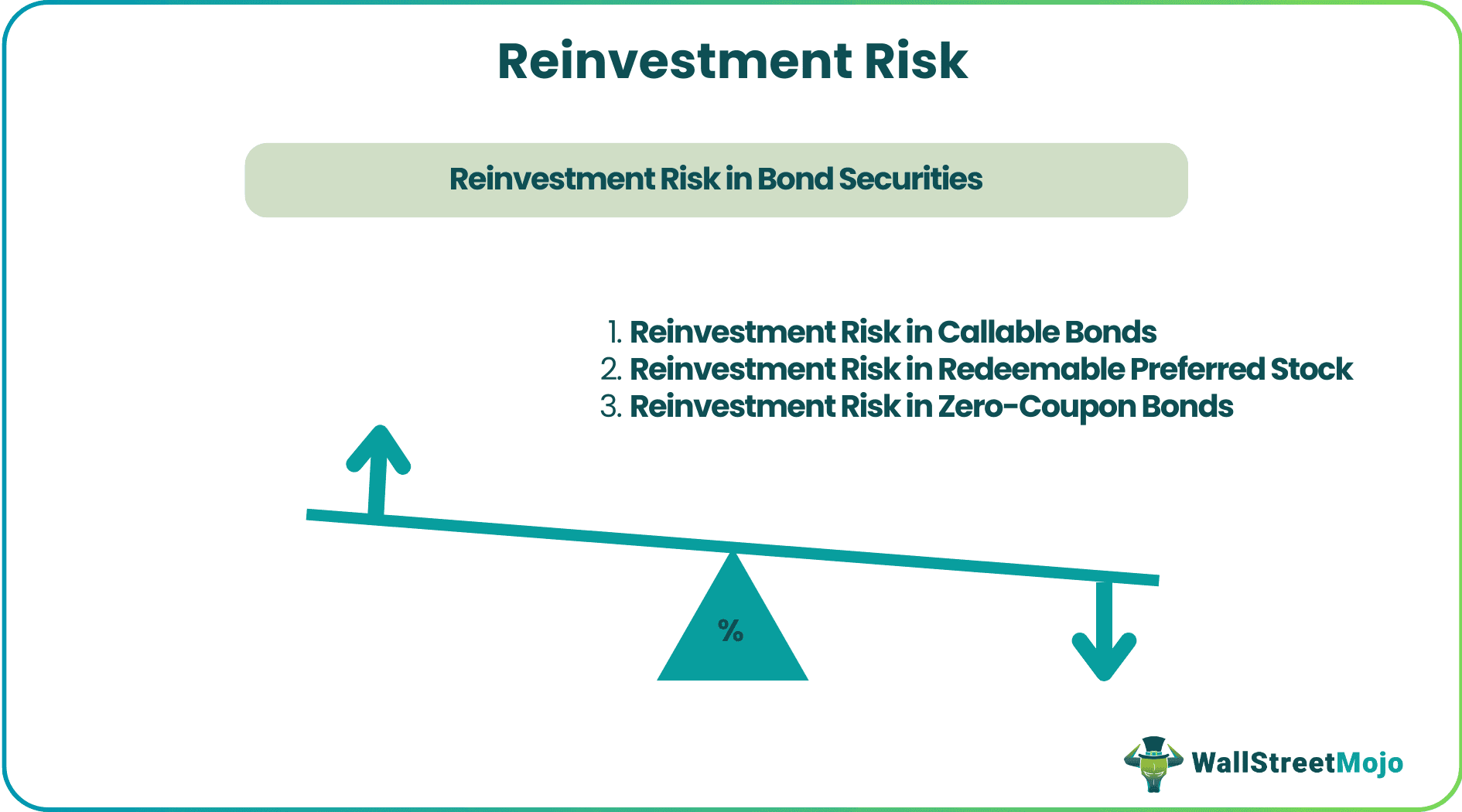Table Of Contents
What is Reinvestment Risk?
Reinvestment risk is a kind of financial risk that is associated with the possibility of investing a bond’s cash flows at a rate lower than the expected rate of return assumed at the time of buying the bond. Reinvestment risk is high for bonds with long maturities and high coupons.
Key Takeaways
- Reinvestment risk refers to the chance that cash flows from an investment, such as coupon payments or principal repayments, may need reinvestment at lower interest rates or inferior investment opportunities.
- Reinvestment risk is particularly relevant for fixed-income investments with a known future cash flow stream, such as bonds or certificates of deposit (CDs), where the timing and magnitude of cash flows are predetermined.
- Factors that can increase reinvestment risk include declining interest rates, early principal repayments, or changes in the investment environment that limit the availability of attractive reinvestment options.
- Investors can manage reinvestment risk by considering investments with staggered maturities, diversifying their portfolio, or using investment strategies such as bond laddering to spread out the impact of reinvestment over time.
How is it Different from Interest Rate Risk?
Any adverse or unfavorable change in the bond market statistics arising due to changes in the prevailing interest rates is collectively grouped under interest rate risk. Interest rate risk comprises of reinvestment risk and price risk. Bond prices are inversely related to market interest rates. So, when rates rise, prices decline. This is often termed as price risk in a bond market.
Reinvestment Risk in Bond Securities
#1 - Reinvestment Risk in Callable Bonds
A callable bond is a type of bond where the issuing company reserves the right to redeem the bond any time before maturity. Callable bonds carry high coupons in order to compensate for the factor of callability. Such bond issuers are always looking to grab any opportunity of debt refinancing in the event of falling rates leaving the investors with the dilemma of reinvesting the proceeds at lower rates, thus leading to the risk of reinvestment.
#2 - Reinvestment Risk in Redeemable Preferred Stock
Redeemable preferred stock is a kind of stock where the issuer can buy it back at a specific price. Upon redemption, the investor is left with the proceeds to be reinvested for a good return, which might not be a very favorable idea when interest rates have fallen.
#3 - Reinvestment Risk in Zero-Coupon Bonds
This is not as pronounced in zero-coupon bonds as in the above. In the absence of coupon proceeds, investors just have to deal with the reinvestment of the maturity amount.

Examples of Reinvestment Risk
Example #1 - Treasury note and Reinvestment Risk
An investor buys an 8-year $100,000 Treasury note, giving a 6 percent coupon ($6000 yearly). In the duration of the next 8 years, rates decline to 3 percent. The investor receives a yearly coupon of $6000 for 6 years and the face value at maturity. Now, one can ask, where lies the reinvestment risk?
Reinvestment risk is manifested when the investor tries to invest the proceeds from the the Treasury note at the prevailing rate of 3 percent. He is no longer entitled to the 6 percent yearly return.
Example #2 - Callable Bonds and Reinvestment Risk
ABC Inc has issued a callable bond with call protection of 1 year and gives a 7 percent coupon. After 1 year, interest rates decline to reach 4 percent. Looking at the opportunity to refinance its debt at the lower rate, ABC Inc decides to call the bond back. By that time, the investor would have received the 7 percent coupon for a year and the principal along with the agreed call premium. This cash flow would then be reinvested at 4 percent rather than the earlier 7 percent, exposing the investor to reinvestment risk.
Disadvantages of Reinvestment Risk
- Realized yield is lower than the expected rate of return, i.e., the YTM or yield to maturity.
- No one is completely immune to this risk since it is virtually everywhere, in every market.
- Investors with a knack for investing in short term bonds often fall prey to this kind of risk.
Managing Reinvestment Risk
- Investing in zero-coupon bonds – These do not entail periodic payments. Hence the risk stands mitigated as investors only have to think about investing the maturity value (face value in this case). These bonds are payable with a discount to its face value.
- Investing in non-callable bonds – This helps in risk reduction by delaying the final payment until maturity while it continues to earn coupon till then. The investor can still have to face the risk of maturity.
- Creating a bond ladder – A bond ladder can be defined as a well-diversified portfolio of bonds where the loss in one security could be offset by gains in the other.
- Selecting bonds that have the provision of providing the cumulative option to investors, where proceeds from the bond get reinvested in the same bond.
- Hiring an experienced fund manager.
Limitation
A few studies on quantification of reinvestment risk have been conducted out of which the Discrete-Time model and the General profit method have gained some relevance, but none of them can provide an accurate estimate since the prediction of the future direction of interest rates would always be dependent on a number of uncertain factors.
Conclusion
One’s calculation of bond price as the present value of all future cash flows is based on the assumption that all future cash flows are reinvested at YTM or the expected rate of return. Even the slightest change in market rates impacts that calculation and eventually impacts our finances. Constructing a well thought of and researched bond portfolio does help in risk reduction to some extent. However, complete elimination is not possible.

